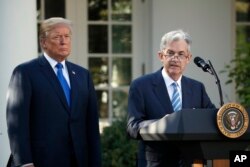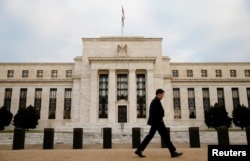A revamping of the Federal Reserve's leadership is widening with the announcement Monday that William Dudley, president of the New York Fed and the No. 2 official on the Fed's key interest rate panel, will retire next year.
Just last week, President Donald Trump chose Fed board member Jerome Powell to replace Janet Yellen as Fed chair in February. The post of Fed vice chair remains vacant. So do two additional seats on the Fed's seven-member board. And a fourth seat may open as well next year.
The unusual pace of the turnover has given Trump the rare opportunity for a president to put his personal stamp on the makeup of the Fed, which operates as an independent agency. Investors are awaiting signals of how Trump's upcoming selections might alter the Fed's approach to interest rates and regulations.
Trump has made it known that he favors low interest rates. He has also called for a loosening of financial regulations. The Fed has played a key role in overseeing the tighter regulations that were enacted after the 2008 financial crisis, which nearly toppled the banking system.
The uncertainty surrounding the Fed's top policymakers has been heightened by the slow pace with which the Trump administration has moved to fill openings.
To date, the administration has placed one new person on the Fed board: Randal Quarles, a veteran of the private equity industry who is thought to favor looser regulations, was confirmed as the first vice chairman for supervision. That still left three vacancies on the Fed's board: Just as Quarles was joining the board last month, Stanley Fischer was stepping down as Fed vice chairman.
And Yellen herself could decide to leave the board when her term as chair ends on Feb. 3, even though her separate term on the board runs until 2024.
Dudley's announcement that he plans to retire by mid-2018 also creates an opening on the committee of board members and bank presidents who set interest rate policies. Dudley's position is particularly crucial: As head of the New York Fed, he is a permanent voting member of the Fed committee that sets interest rates.
The committee is composed of the board members and five of the 12 regional bank presidents. Unlike the New York Fed president, the other regional bank presidents vote on a rotating basis. The New York Fed president also serves as vice chairman of the rate-setting panel.
Some economists said that while financial markets have so far registered little concern about the number of key open Fed positions, that could change quickly, especially if investors begin to worry that the central bank will accelerate interest rate hikes.
"We need to get rid of this uncertainty, and until these seats are filled, there is going to be uncertainty,'' said Diane Swonk, chief economist at DS Economics.
Analysts are trying to read the two decisions Trump has made — picking Powell for the top job and Quarles for the key post for banking supervision — as signs for where he might be headed. With Powell, the president opted for continuity on rates by selecting someone who for years was the lone Republican on the board but who remained a reliable vote for the gradual approach to rate hikes Yellen favored.
And in the bank supervision post, analysts say Trump might have been signaling that he wants to reverse, or at least weaken, Yellen's backing of the reforms instituted by the 2010 Dodd-Frank financial overhaul law. During the campaign, Trump argued that Dodd-Frank was harming the economy by constraining back lending.
Quarles has been critical of aspects of that law. To a lesser extent, so, too, has Powell, who will be the first Fed chairman in nearly 40 years to lack a degree in economics. Powell, a lawyer by training, amassed a fortune as an investment banker at the Carlyle Group.
"With his background, Powell can be expected to work well with Wall Street and the business community in general,'' said Sung Won Sohn, an economics professor at California State University, Channel Islands.
A senior administration official indicated that one important attribute for the open positions will be a diversity of backgrounds.
"We believe the Fed will function best with a wide range of skill sets,'' said the official, who spoke on condition of anonymity to discuss personnel decisions. This official would not give a timetable for when the administration's next nominations for the Fed might occur.
Though Trump will choose officials to fill the openings on the board, the choice of Dudley's replacement will fall to the board of the New York Fed. The New York Fed said a search committee had been formed to choose a successor to Dudley, who joined the New York Fed in 2007 after more than two decades at Goldman Sachs.
The announcement from the New York Fed said Dudley, 64, intended to step down in mid-2018 to ensure that his successor would be in place well before the mandatory end of Dudley's term in January 2019.
After overseeing the New York Fed's securities operations for two years, Dudley succeeded Timothy Geithner as its president after Geithner was tapped by President Barack Obama to become Treasury secretary in 2009.
Dudley won praise for the work he did with Geithner and Fed Chairman Ben Bernanke to contain the fallout from the 2008 financial crisis. Dudley supported Yellen's cautious approach to raising the Fed's benchmark rate and the plan the central bank has begun to gradually shrink its $4.5 trillion balance sheet, which is five times its size before the financial crisis.
The balance sheet contains $4.2 trillion in Treasurys and mortgage bonds that the Fed bought since 2008 to try to hold down long-term borrowing rates and help the economy recovery from the worst recession since the 1930s.
In a statement, Yellen praised Dudley for his "wise counsel and warm friendship throughout the years of the financial crisis and its aftermath.''












